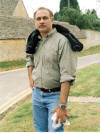|
|
the-south-asian.com July / August 2006 |
|
|||
|
August/September Contents
Sufis - wisdom against 50
years of mountain Heritage cities:
Cotton - the fibre of
|
|
||||
|
Page
3 of 6
Harappan Heritage by Salman Minhas
First published June 2005
Culture, Technology, Trade: Cotton Textiles: At Sahiwal [the old town name was Montgomery, pronounced "Mint-gumri" in Punjab], a road takes off for Pakpattan [ the old town of Ajodhan ] about 30 kms to the south-east. Pakpattan is famous for the tomb of the famous Punjabi poet Baba Farid Shakar Ganj , whose works comprise nearly one-third of the Sikh’s holy book called Guru Granth Sahib. About 20 kms towards the west is the town of Kamalia, famous for its hand-woven cotton and factory made Khaddar or Khadi. This is historically part of the Punjab’s cotton belt that starts from the town of Faislabad [or Lyallpur] and goes all the way down towards the towns in Sind near the other famous Indus Valley archaeological site at Mohenjo-Daro near Larkana on the Indus River. The old cotton with its natural off-white and camel colors is still cultivated by the farmers at Burewala, a town south west of the main highway and railway line from Lahore to Multan. One mentions this cotton belt, because at the Harappa Museum, is a beautifully preserved wooden whirling stick which was used to spin cotton into a yarn. Further evidence of earthen cotton spinning wheel was also found. The people at Harappa lived with this cotton technology and the potter’s wheel, and their furnaces [achieving temperatures of 1400 Centigrade ] where their metals technology – basically copper, gold and quality glazed earthen-ware [ steatite –magnesium silicate, talc] was brought to a high level of perfection around 2800 BC. Cotton fabric was found in Mohenjo-Daro and in Mesopotamia along with indigo plants that grew in abundance on the banks of the Indus river.
Urban Town Planning & Water Engineering : "Architecture starts when you carefully put two bricks together. There it begins." [Ludwig Mies van der Rohe , German born American Architect. 1886-1969] If one accepts the above dictums of Mies Van Der Rohe, then the most inspiring element with which the Indus valley civilization [ IVC] confronts the novice tourist are the elements of town planning, public heated baths, main and smaller streets, citadel like fortress structure, covered drains, use of baked bricks. The baked bricks are unlike the Mughal bricks left by history. They are much larger in length and wider. For town planning, Harappa & MohenjoDaro existed as essentially polar-aligned, pre-planned urban settlements, the few large sites usually divided into a lower town and an incorrectly labeled 'citadel.' There was frequent architectural use of mud brick platforms. In terms of city water supplies, there was a fastidious, almost fanatical, attention to sanitary engineering, water control, including a plethora of hydraulic features such as drains, wells, dump pits, baths, and bathrooms. Irrigation of crops during the winter or non-flood winter season was done using the lift mechanism of the "Shaduf" tool [bucket on a bamboo lever]. Both Harappa & MohenjoDaro cities were a mile square [ about 3 miles in circumference] , parallelogram shaped 400 yards by 200 yards and with defensive outer walls. An orthogonal street layout was oriented toward the North-South & East-West directions. The street layout shows an understanding of the basic principles of traffic, with rounded corners to allow the turning of carts easily. These streets divided the city into 12 blocks. Except for the west-central blocks, the basic unit of city planning was the individual house. The Harappan house is an amazing example of a native people, without the benefit of technology, adapting to local conditions and intuitively producing a vernacular architecture eminently suited to the climate. The house was planned as a series of rooms opening on to a central courtyard. This courtyard served the multiple functions of lighting the rooms, acting as a heat absorber in summer and radiator in winter, as well as providing an open space inside for community activities. There were no openings toward the main street, thus ensuring privacy for the residents. In fact, the only openings in the houses are rather small - this prevented the hot summer sun heating the insides of the houses. An advanced drainage system is also in evidence. Drains started from the bathrooms of the houses and joined the main sewer in the street, which was covered by brick slabs or corbelled brick arches, depending on its width. In most of the sites, the central-western blocks were reserved for public architecture. Perhaps the most famous examples are the Great Bath and Granary at Mohenjo-daro. The Great Bath has been the subject of much debate over its exact function. The prevalent view seems to be that it was used for ritualistic bathing. Jewelry
Religious symbols & rituals : Elements of religious symbols, [the reverse swastika being the notable icon copied by Nazi Germany], the various postures of yoga, the male & female fertility symbols of the lingam and the yoni still survive without much change in south Asian cultures such as in India & Pakistan. Bathing rituals among Hindus seem to be based on the sanitary engineering standards reached in Harappa .
|
|||||
|
Copyright © 2000 - 2006 [the-south-asian.com]. Intellectual Property. All rights reserved. |
|||||

